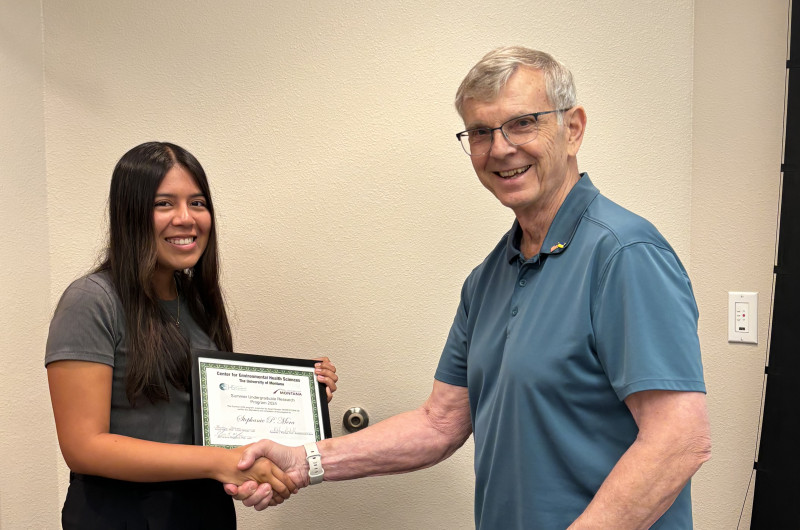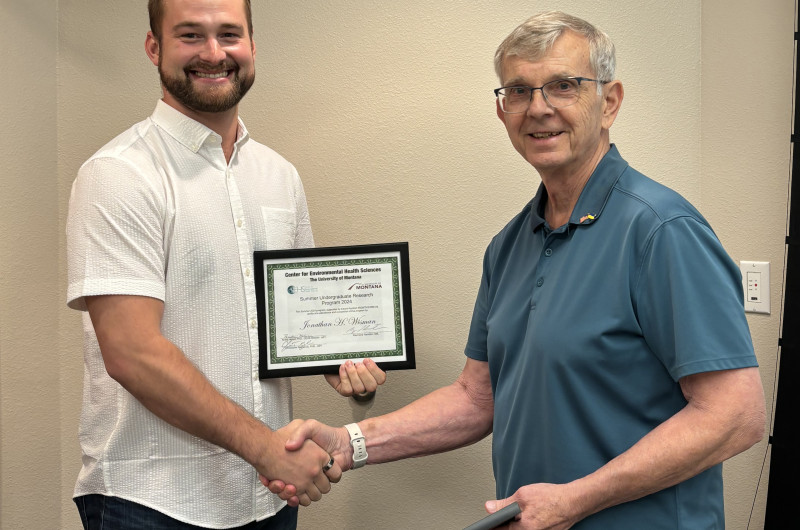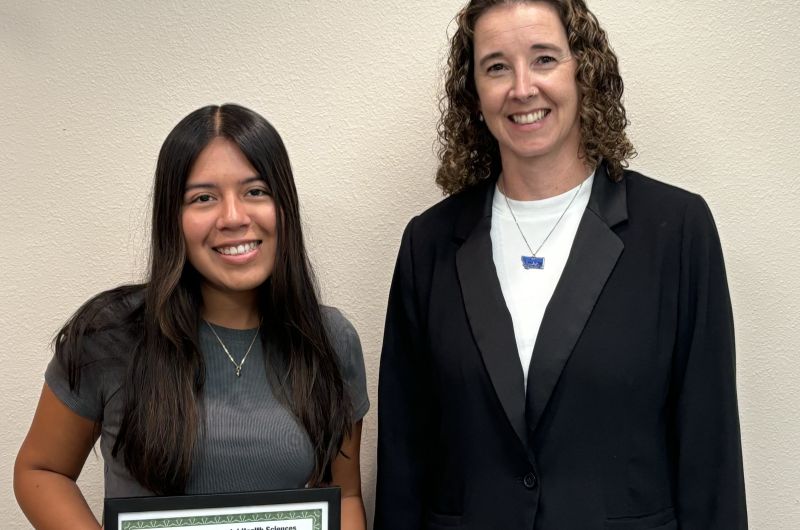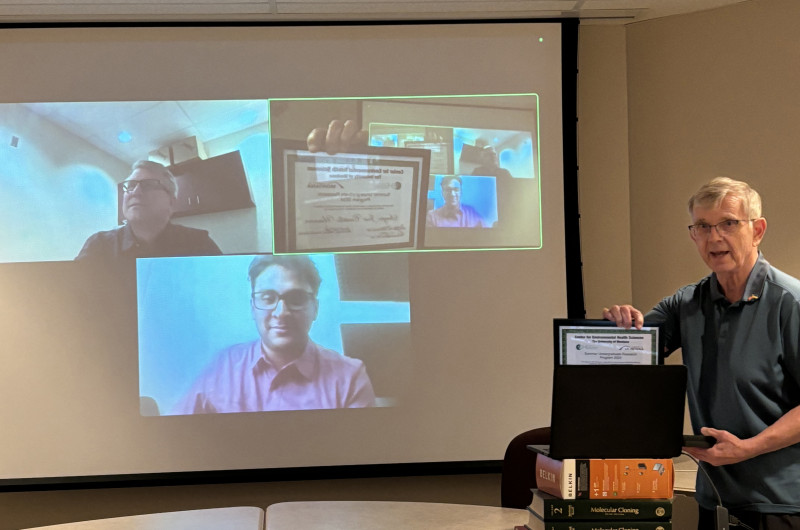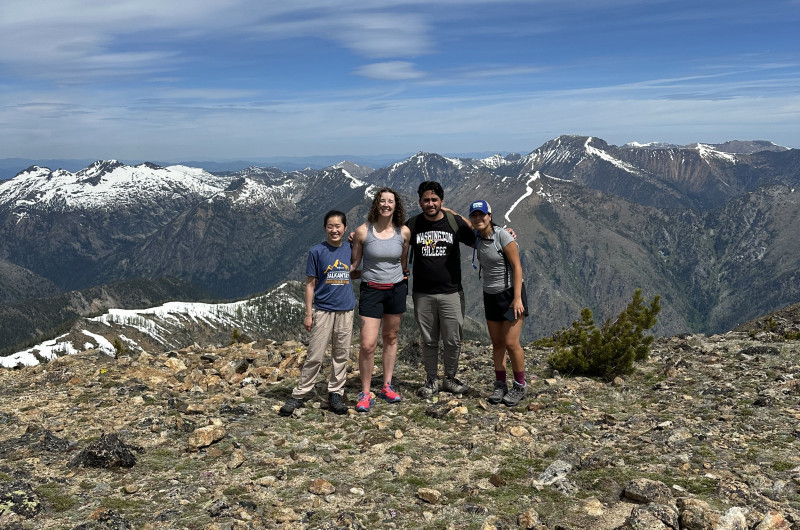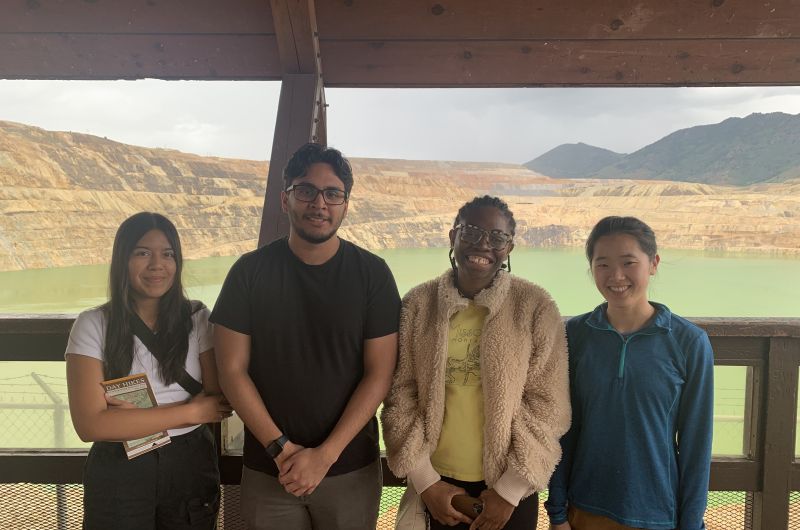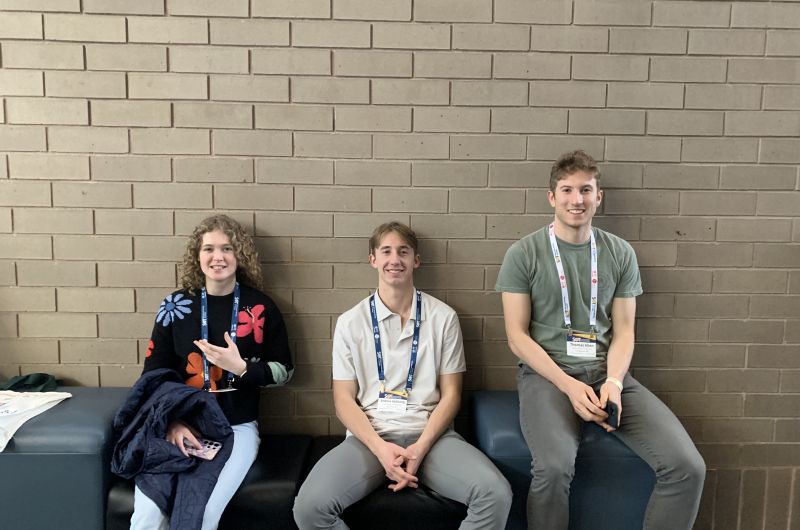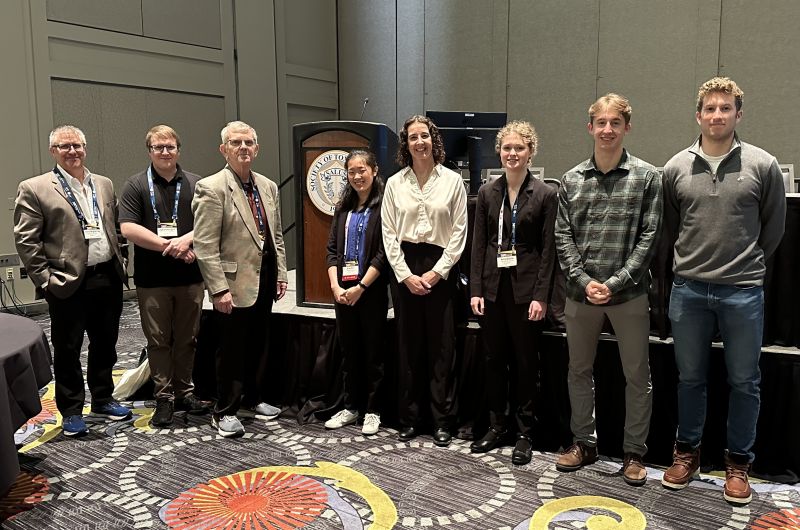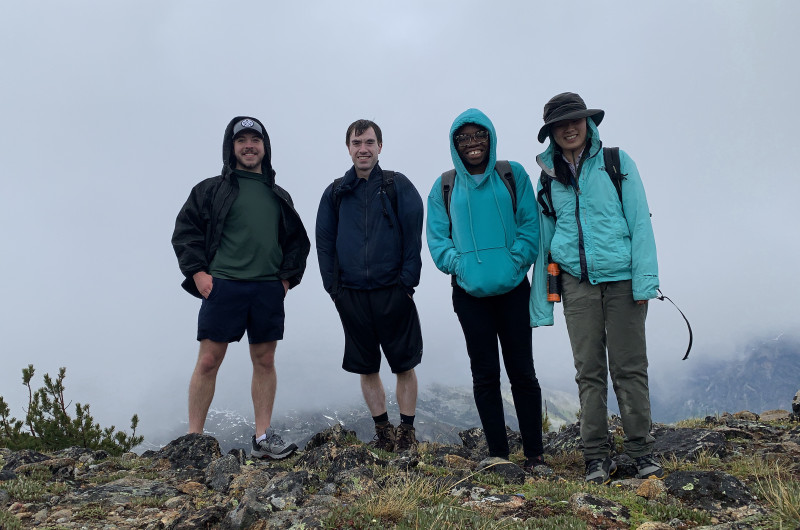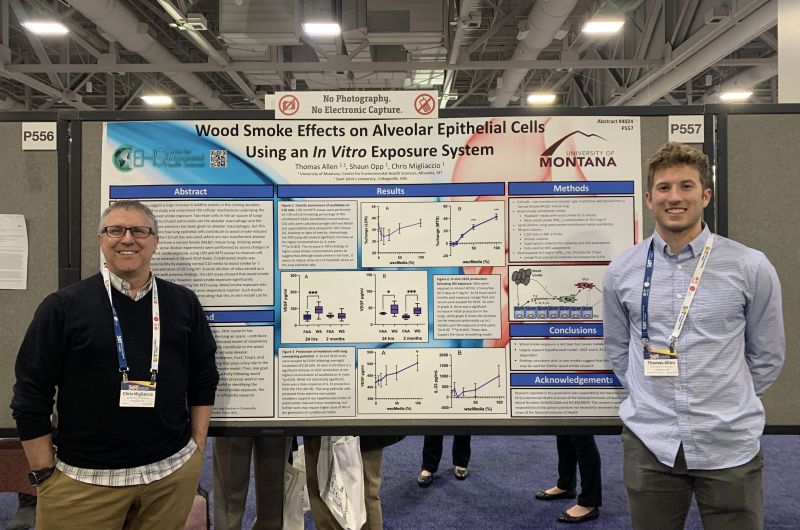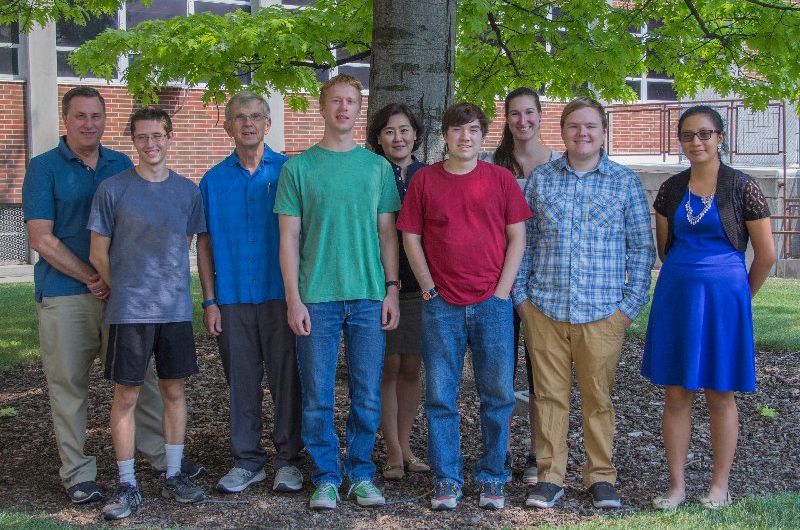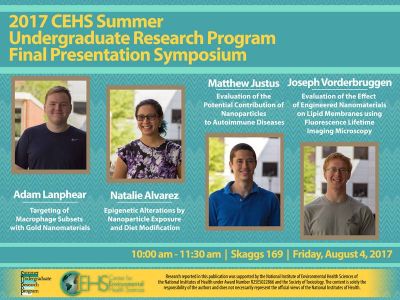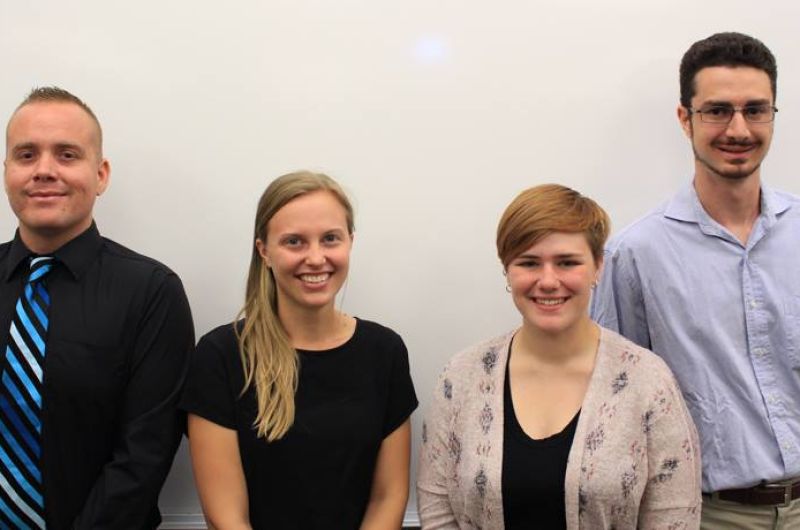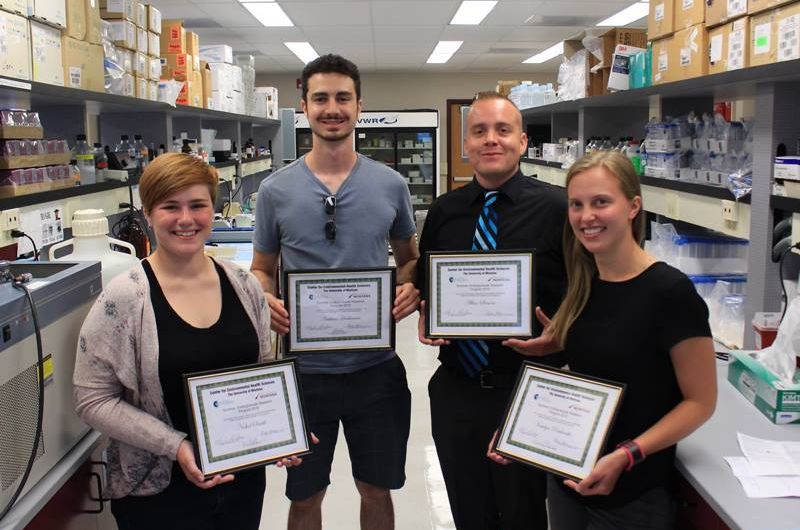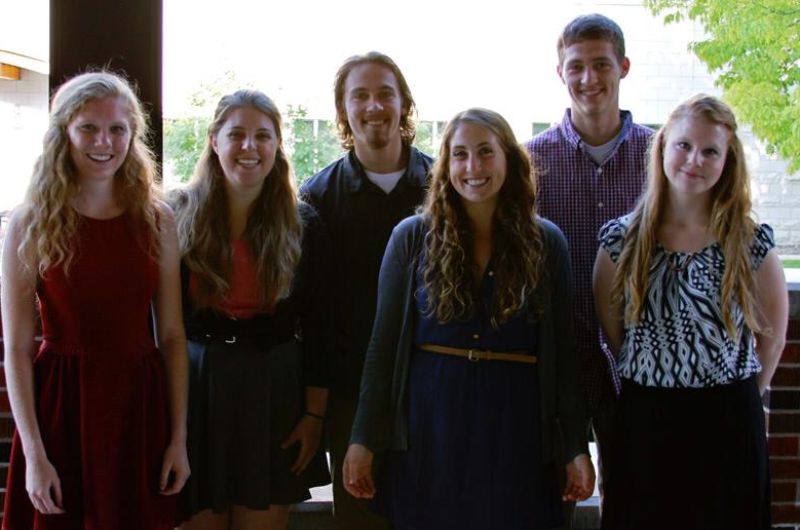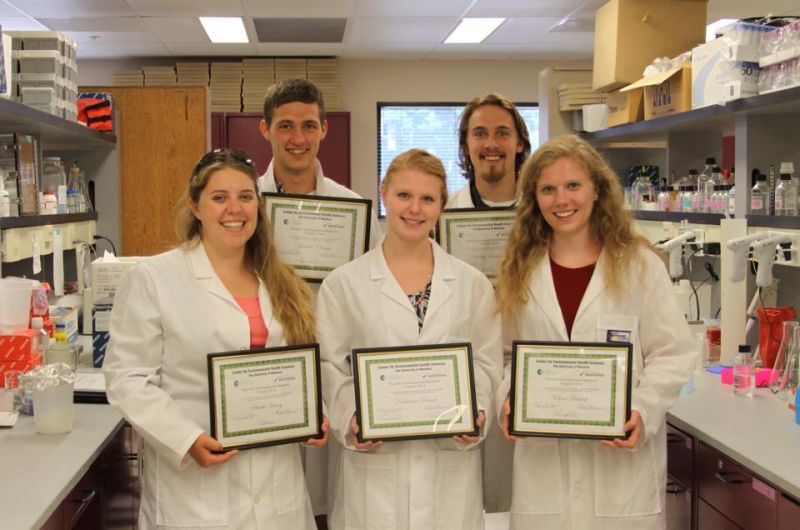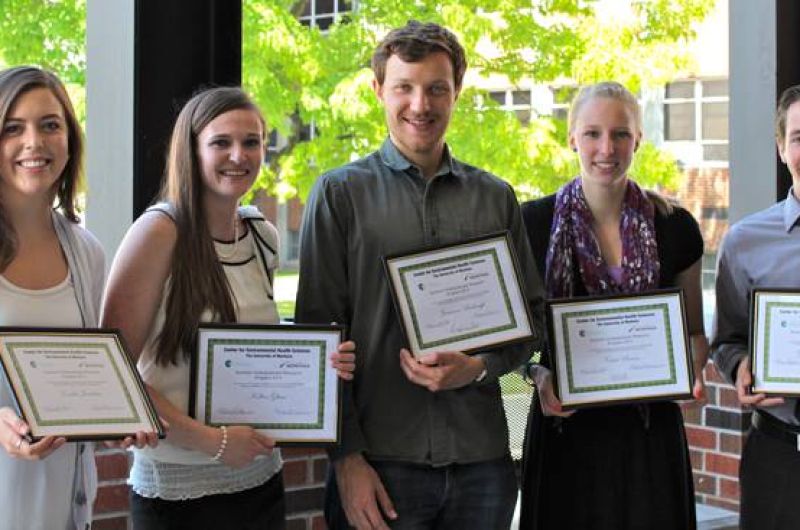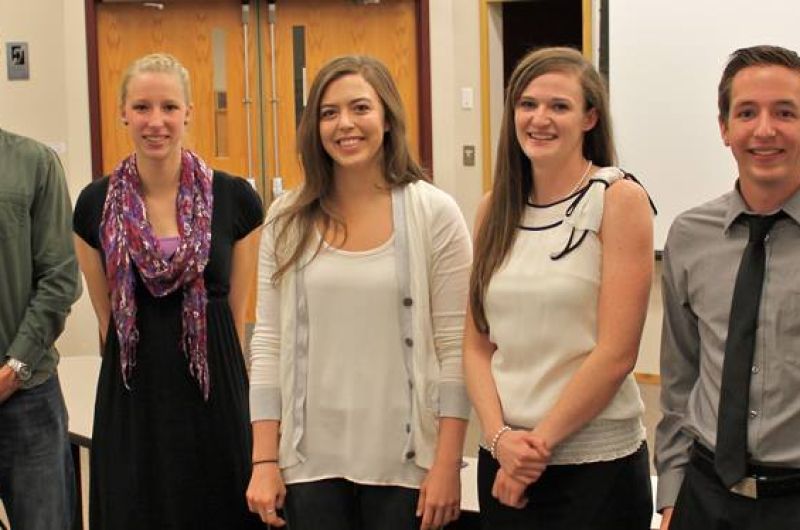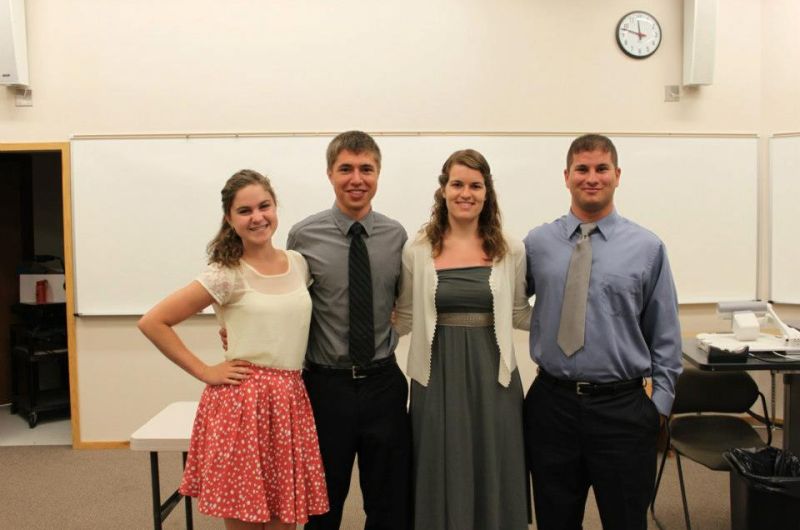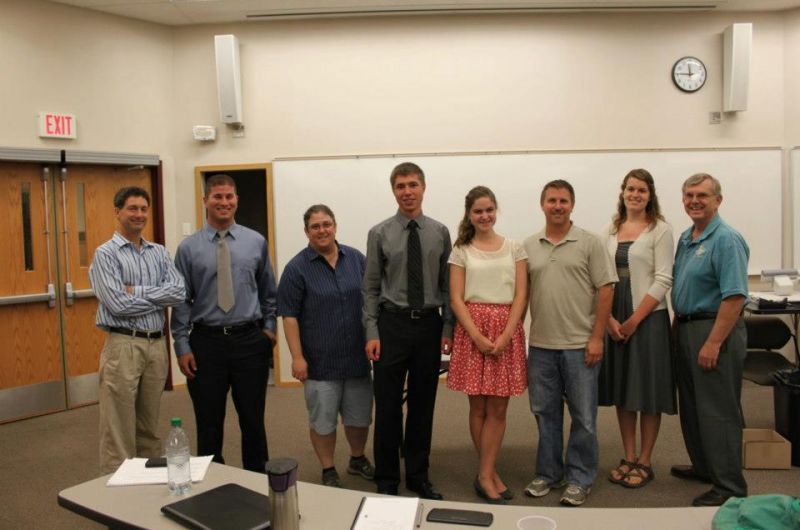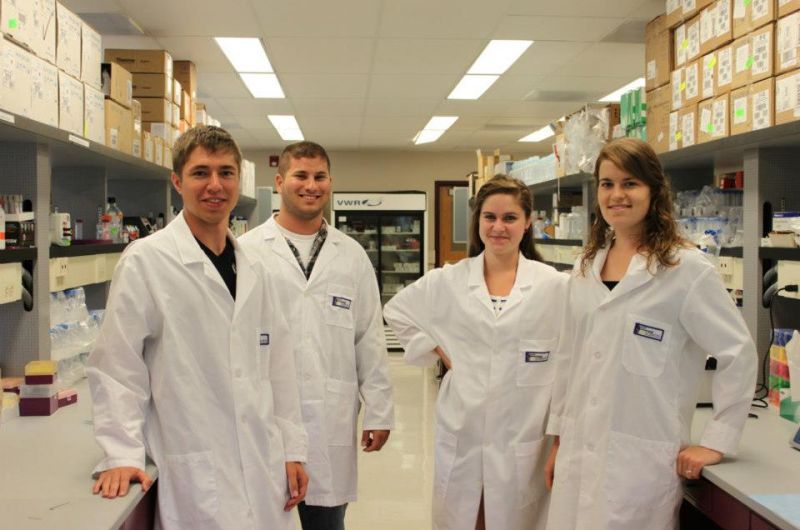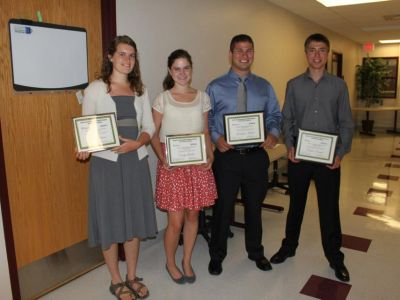SURP Through the Years
The Center for Environmental Health Sciences sponsors a summer educational research experience for outstanding college undergraduates. The Summer Undergraduate Research Program (SURP) is part of a national program to attract and train undergraduates to research careers in the environmental health sciences.
SURP 2024
SURP 2023
-
Mentor: Christopher Migliaccio, PhD, PharmD., Research Associate Professor
SURP Student: Amy Boote, SOT Intern, Sentinal High School, Missoula
Year: 2023
Background and Purpose: Climate change has increased the number and severity of wildfires in the Western United States, resulting in increased exposure to wildfire smoke. Current literature indicates that wildfire smoke exposure is associated with a sustained decrease in lung function. However, very little research has been done to determine if repeated exposures to wildfire smoke have cumulative adverse health effects, including on lung function. Communities in the west, such as Missoula, MT, have a significant history of wildfires, experiencing repeated exposures with an unknown effect on pulmonary function. The work in this pilot study was conducted in Missoula, MT, to determine whether repeated exposures, especially during adolescence and early adulthood, have a cumulative impact on lung function.
Methods: Data of historical fine particulate matter (PM2.5) concentrations from 1999-2023 in twelve counties in Western Montana were obtained from the website of Environmental Protection Agency and used to determine community-level historical exposures. Through the use of posted flyers, email advertisements, and word of mouth, a cohort of approximately twenty adult residents of Missoula County, ages 18 to 30, with no history of smoking or vaping was recruited. Subjects completed a questionnaire detailing their residential, medical, occupational, and activity level history. In addition, their residential history was utilized to determine individual exposure history to wildfire smoke. Subjects completed spirometry where the observed results were compared to calculated values based on RASH (race, age, sex, height).
Results: Community-level exposures to PM2.5 sourced from wildfire smoke significantly increased from the period 1999-2010 to 2011-2022, in terms of both season length and PM burden. Missoula County experiences significantly higher levels of exposure than the rest of Western Montana.
Conclusions: This study illustrates the appropriateness of using Missoula, MT, as a community to assess a cumulative effect of wildfire smoke exposures. A young adult cohort is useful to determine whether a history of childhood exposures affects lung function in early adulthood. -
Mentor: Christopher Migliaccio, PhD, PharmD., Research Associate Professor
SURP Student: Tommy Allen, SOT Intern, College of Saint Benedict and Saint John’s University, MN
Year: 2023
Background and Purpose: As predictive models suggest a large increase in wildfire events in the coming decades, there is a pressing need to study and understand the cellular mechanisms underlying the pathology derived from woodsmoke exposure. Two main cells in the air spaces of lungs that are routinely exposed to inhaled particulates are the alveolar macrophage and the alveolar epithelial cells. Much attention has been given to alveolar macrophages, but this experiment sought to explore how lung epithelial cells contribute to woodsmoke-induced adverse health outcomes.
Methods: The C10 cell line was used, which are non-transformed alveolar type II epithelial cells derived from a normal female BALB/c mouse lung. Utilizing woodsmoke-conditioned media, serial dilution experiments were performed to assess changes in C10 activity following woodsmoke exposure, using LDH and MTS assays to measure cell viability as well as ELISAs to measure IL-33 and VEGF levels. Conditioned media was generated in our exposure facility by exposing normal C10 media to woodsmoke for 5 minutes at an average concentration of 39.5 mg/m3. A serial dilution of silica served as a positive control.
Results: Consistent with previous findings, the LDH assay showed that woodsmoke exposure was not toxic. Interestingly, however, woodsmoke exposure significantly increased mitochondrial activity as denoted by the MTS assay. Woodsmoke exposure also significantly increased VEGF levels in a consistent dose-dependent manner.
Conclusions: Such results have been shown in previous in vivo studies, demonstrating that this in vitro model can be pursued for future woodsmoke exposure studies. -
Mentor: Andrij Holian, PhD, Professor, Director CEHS; Biostatistician: Raymond Hamilton, MS
SURP Student: Dominic Amon, SOT Intern, College of Saint Benedict and Saint John’s University, MN
Year: 2023
Background and Purpose: Inhalation of engineered nano-materials (ENM) is a concern for human health. After deposition in the lungs, ENM are phagocytosed by alveolar macrophages. After phagocytosis, some ENM have the ability to cause phagolysosome membrane permeabilization (LMP). As LMP occurs, the degradative enzymes of phagolysosome leak into the cytosol, triggering the macrophage’s inflammation response, leading to the formation of the NLRP3 inflammasome. Subsequently inflammatory cytokines such as IL-1ß and IL-18 are released. The exact mechanism by which inhaled ENM cause LMP remains unknown and makes a prime target for investigation. If the mechanism for ENM-induced LMP can be determined it could lead to prevention and treatment. Surface functionalization is predicted to alter the interaction between the ENM and phagolysosomal membrane, thus affecting LMP. This project examined how surface functionalization of two types of ENM, Antimony molybdenum oxide (SMO) and nickel oxide (NiO) affected membrane permeabilization in an RBC model along with cytotoxicity in an alveolar macrophage model.
Methods: Non-surface functionalized particles (bare) along with hydroxylated and carboxylated particles were tested for each type of ENM.
Results: Hydroxylated particles produced the most hemolysis for both SMO and NiO. Carboxylation of NiO reduced the hemolysis when compared to the bare and hydroxylated particles. In alveolar macrophages, carboxylation also reduced the cytotoxicity of NiO particles. However, with SMO particles all surface modifications remained extremely cytotoxic, which suggested a different mechanism of action compared to NiO particles.
Conclusions: Future work will investigate the amount of LMP produced by SMO particles and other mechanisms of action beyond LMP. With NiO particles, surface functionalization altered the ability of the ENM to cause membrane permeabilization and cytotoxicity in macrophage, suggesting a possible safer design of these materials. Funding provided by R25ES022866 and R01ES033533. SOT Intern support. -
Mentor: Andrij Holian, PhD, Professor, Director CEHS; Biostatistician: Raymond Hamilton, MS
SURP Student: Andrew Gebhardt, SOT Intern, Colorado School of Mines, CO
Year: 2023
Background and Purpose: The NASA Thrive in Deep Space (TIDES) program is dedicated to the advancement of space exploration, with a specific focus on lunar and Martian missions. An area of concern within these missions is the potential toxicity and inflammatory effects associated with respirable-sized lunar and Martian dusts. Prior studies have shown that lunar and Martian regolith simulants, characterized by their high silica content, can induce toxic reactions, including lung inflammation, which may lead to lung fibrosis and silicosis. These adverse health outcomes can be attributed to nearly free silanols (NFS) found on the silica surface. Once these particles are phagocytosed by alveolar macrophages they are internalized into lysosomes. NFS on the surface of silica have a disruptive effect on lipid membranes, particularly within lysosomes leading to cellular toxicity and inflammation.
Methods: In this study, we sought to investigate the relative toxicity and underlying mechanisms of lunar regolith simulant JSC-1 and Martian regolith simulant JSC-MAR-1 in inducing inflammation. To expedite data collection while minimizing the need for vertebrate testing, a novel model using murine ex vivo alveolar macrophages (mexAM) derived from primary alveolar macrophages (AM) of C57BI/6 mice was employed. Cytotoxicity assays were conducted to establish dose-response curves for the regolith simulants, with quartz silica and TiO2 used as positive and negative controls, respectively.
Results: Results revealed that the toxicity of lunar and Martian regolith simulants was intermediate between that of TiO2 and crystalline silica. Furthermore, measurements of inflammatory cytokines IL-1β and IL-18 indicated comparable levels of NLRP3 inflammasome activation. Here we show that while lunar and Martian dust simulants do exhibit toxicity, their levels fall between those of TiO2 and crystalline silica.
Conclusions: Thus, significant levels of inflammation and chronic diseases would require higher concentrations or extended exposure to these simulants compared to crystalline silica. Accordingly, mitigation measures should be implemented for lunar and Martian dusts, although the level of concern need not equal crystalline silica. These findings provide crucial insights into health considerations for future space exploration endeavors. Funding provided by R25ES022866. SOT Intern support.
SURP 2022
-
Mentor: Christopher Migliaccio, PhD
SURP Student: Kai Malone, SOT Intern, University of North Carolina at Chapel Hill, NC
Year: 2022
-
Mentor: Ethan Walker, PhD SURP Student: Abby McIver, SOT Intern, East Tennessee State University, TN Year: 2022
SURP 2021
-
Mentor: Andrij Holian, PhD, Professor, Director CEHS; Biostatistician: Raymond Hamilton, MS
Graduate Student: Rebekah Kendall, PhD Candidate, PreDoctoral-NRSA Recipient
SURP Student: Yaneiza González Altieri, SOT Intern, University of Puerto Rico at Aguadilla
Year: 2021
Silicosis is a chronic inflammation disease where currently no cure is available. This disease occurred after exposure of silica (cSiO2) particles that affects the Lysosome Membrane Permeabilization (LMP) of the phagolysosome in macrophages. Resulting in a leakage of cathepsin and other proteases that activate the NLPRP3 inflammasome complex and secretion of the proinflammatory cytokines. This study was design to use two Food and Drug Administration (FDA) approved antidepressant drugs in mice macrophage cells as a treatment for silicosis to repurpose these drugs. Our hypothesis is that antidepressant drugs will decrease the silica-induced inflammation response in Murine Bone Marrow derived Macrophages (BMdM) and Alveolar Macrophages (AM) without causing cytotoxicity. BMDM and AM pre-treated with Fluvoxamine and Fluoxetine, respectively, for 30 minutes prior to cSiO2 exposure (50 µg/mL). cSiO2-exposed cells were seeded at 1×105 cells per well in a 96-well plate and incubated 24 hr (37ºC, 5% CO2). After 24 hr, cells and supernatants were assayed with Lactate Dehydrogenase (LDH, Promega) and MTS tetrazolium compound (MTS, Promega) assays to determine cytotoxicity. Supernatants were analysed by ELISA (R&D) for IL-1β levels. Using dose response results in BMdM we move on using a specific dose for AMs. As a result, the fluvoxamine (1 µM) and fluoxetine (5 µM) have reduction of the IL-1β and did not present cytotoxicity effect on both immune cells. In conclusion, both treatments reduced the crystalline silica-induced inflammation in mice immune cells without causing cytotoxicity. This FDA approved drugs could be repurpose as a treatment for chronic inflammation disease. Additional studies were needed to make sure that the proposed mechanism of the drugs is directly reducing the LMP and move on to human immune cells.
-
Mentor: Andrij Holian, PhD, Professor, Director CEHS; Biostatistician: Raymond Hamilton, MS
Graduate Student: Rebekah Kendall, PhD Candidate, PreDoctoral-NRSA Recipient
SURP Student: Kathryn Lund, The Ñý¼§Ö±²¥ – Western
Year: 2021
Acrolein is a colorless, acrid-smelling chemical commonly produced by tobacco smoke, cooking grease, and the dehydration of glycerol to form other compounds such as biocides. Exposure to acrolein can cause negative health effects such as nose, skin, and respiratory irritation. Toxic effects due to acrolein can vary depending on the dose and duration of exposure. Acrolein is the simplest beta-unsaturated aldehyde, with an electrophilic-alpha carbon and carbonyl group making it highly reactive. Due to its chemical composition, acrolein is known to interact with nucleophiles and important proteins and enzymes involved with immune response. Previous studies suggested that acrolein interacts with two important proteins, transient receptor potential cation channel (TRPA1) and protein tyrosine phosphatases (PTP1B), involved in signaling lung macrophages. PTP1B binds to the enzyme src kinase, allowing it to activate NF-B, a regulator of inflammation. Modification of PTP1B (a negative regulator of M2 macrophages) due to acrolein, could result in increased M2 macrophage phenotype and produce toxic health effects after exposure. The hypothesis of this study is PTP1B in alveolar macrophages (AM) is a key target of acrolein exposure resulting in inhibited cytokine release in response to LPS. Experiments were carried out in vivo and in vitro to detect levels of PTP1B and src kinase in mouse AM and bone marrow derived macrophages (BMdM). Mice used in vivo were exposed to 4 mg/kg of acrolein, and AMs were lavaged following exposure. BMdM and AM cells used in vitro were cultured and exposed to acrolein one hour before assays were performed. Western blots and BCA assays were used to determine protein concentrations and detect PTP1B and src kinase in exposed cells. AM and BMdM were exposed to LPS, and ELISA assays were run to record the level of cytokines TNF- and IL-6. Results of the in vivo study confirmed that src kinase disappears when exposed to varying doses of acrolein. Western blots showed no decrease in PTP1B or detected acrolein adducts on proteins, suggesting that acrolein may target src kinase specifically. Results of the in vitro study suggest that AM were a more sensitive model over BMdM, assay detection of src kinase and cytokines was more sensitive in AM model. Additional work could be beneficial to understanding exact mechanism of acrolein toxicity involving PTP1B and src kinase in macrophages.
-
Mentor: Christopher Migliaccio, PhD, PharmD., Research Associate Professor
SURP Student: Hailey Madison, SOT Intern, The Ñý¼§Ö±²¥ – Western
Year: 2021
Exposure to environmental particles can cause long term health effects including obstructive pulmonary disease. A key cell in the response to inhaled environmental exposures is the alveolar macrophage (AM). The AM plays important roles in both the induction and resolution of inflammatory responses. Efferocytosis is the process in which apoptotic cells are recognized and cleared by phagocytic cells that results in reduction of inflammation, which reduces the production of inflammatory cytokines like TNF. The objective of this study is to assess the effects of environmental particles on macrophage functions and the inflammatory process. This study utilized ex vivo and in vitro methods to collect AM and bone marrow-derived macrophages (BMdM). Using an efferocytosis assay, macrophages were cultured with apoptotic bait cells and assessed by flow cytometry. AM were collected from wood smoke (WS) and filtered air (FA) exposed mice, while BMdM were exposed in vitro to five modified crystalline silica particles. Additionally, freshly isolated AM were utilized for ex vivo cultures with LPS-stimulation and cytospin analyses. An ELISA was performed to measure LPS-induced inflammatory cytokines from the ex vivo cultures. The results of the WS-exposed AM versus FA-exposed AM assay showed that WS exposed mice had a lower percent of cells that had performed efferocytosis after 24 hours and even lower two months post WS exposure. Cytospin results revealed no neutrophil influx, while the ELISA assay showed an increase of TNF from AM 24 hours post WS exposure. These results indicate that following inhaled WS exposures, there appears to be an increase in inflammatory potential with respect to AM functions. In addition, exposure of BMdM to modified crystalline silica particles resulted in a dose-dependent decrease in efferocytosis. The present work illustrates a particle effect on the potential for macrophage control of inflammation, as well as a specific and extended effect from inhaled wood smoke.
-
Mentor: Yoon Hee Cho, PhD., MPH, Associate Professor
SURP Student: Gabriela Martinez, University of Puerto Rico at Aguadilla
Year: 2021
Environmental influences can result in physiological changes through epigenetics, which is the study of heritable changes in gene activity or function that is not associated with any change of the DNA sequence itself. Epigenetic modifications such as hypomethylation or hypermethylation have been shown to occur when exposed to persistent organic pollutants (POPs) which are known to disrupt the endocrine system. POPs are chemical substances that persist in the environment and pose a risk of causing adverse effects to human health and the environment. POPs work their way through the food chain by accumulating in the body fat of living organisms and becoming more concentrated as they move from one creature to another. When contaminants found in small amounts at the bottom of the food chain accumulate, they can pose a significant hazard to predators that feed at the top of the food chain. This means that even small releases of POPs can have significant impacts. In this project we worked with a method to estimate DNA methylation, referred to as Luminometric Methylation Assay (LUMA) and this method provides a way to analyze genome-wide DNA methylation in order to predict physiological and pathological conditions. We employed LUMA on DNA samples from the kidneys and gonads of marine mammals to determine their DNA methylation levels and find changes in methylation patters that might correlate with known persistent organic pollutants. After collecting and analyzing the data we didn’t see any significant association between DNA methylation levels and pollutant levels. After comparing these two tissues, there was no statistical difference between the studied tissues.
SURP 2018
-
Mentor: Andrij Holian, PhD, Professor, Director CEHS
Graduate Student: Jessica Ray, Ñý¼§Ö±²¥
SURP Student: Meg Lyons, Troy University
Year: 2018
Alveolar macrophages (AMs) are the primary immune cell type responsible for phagocytizing inhaled particles and initiating the inflammatory response. Crystalline silica and multi-walled carbon nanotubes (MWCNT) are two particles shown to have deleterious effects on lung macrophages. Silica is an environmental and occupational hazard, inhalation being associated with systemic inflammation, lung fibrosis, and autoimmune disease. MWCNT are an emerging concern and present unique challenges in toxicity evaluation due to numerous variables contributing to bioactivity. The exact mechanisms by which both silica and MWCNT exert their toxic effects are unknown, creating the need for a high-throughput in vitro model for analysis.
Because of low AM numbers in naïve mice, bone marrow-derived macrophages (BMdM) are the predominant model used for in vitro assessments. BMdM are able to be cultured in large quantities and allow for the creation of a homogenous population. Granulocyte-macrophage colony-stimulating factor (GM-CSF) and macrophage colony-stimulating factor (M-CSF) are important for differentiation of myeloid progenitors into different macrophage populations. Often times M-CSF is used in vitro to differentiate bone marrow monocytes into macrophages, however, studies have shown that GM-CSF is the necessary factor in the development of alveolar macrophages.
This project will test the hypothesis that BMdM grown in GM-CSF more closely model the response of AMs to MWCNT and silica, than BMdM cultured with M-CSF. For this project, BMdMs will be cultured with GM-CSF and M-CSF, respectively, and the responses of these two populations to silica and MWCNT will be compared to primary murine AMs. Over the summer the student will learn isolation of primary murine alveolar macrophages, sterile technique, cell culture, cytokine measurement via ELISA, viability assays, and analysis of cell populations via flow cytometry.
-
Mentor: Kevan Roberts, PhD and Zeina Jaffar, PhD
SURP Student: Abigail Borden
Year: 2018
-
Mentor: Andrij Holian, PhD, Professor, Director CEHS; Fred Rhoderick, Research Specialist
SURP Student: Caleigh Buckmaster
Year: 2018
-
Mentor: Donald Anderson, PhD, Postdoc
SURP Student: Tia Kohs
Year: 2018
-
Mentor: Christopher Migliaccio, PhD
SURP Student: Ava Orr
Year: 2018
SURP 2017
-
Mentor: Christopher Migliaccio, PhD
SURP Student: Adam Lanphear, Washington College
Year: 2017
Nanoparticles are increasingly utilized in multiple fields such as but not limited to, medicine, clothing, agriculture, and industry. Carbon nanotubes have important uses in many of these fields so understanding their potential for adverse effects is vital. Macrophages are a key component of the immune system and are known to separate into functional subsets that generate distinct responses in the body. Pulmonary macrophages, key regulators of immune responses to respiratory exposures, have not yet fully been separated in subsets. Alveolar macrophages have been broken in subsets such as M1 and M2a while interstitial macrophage subsets have yet to be fully described. Using the alveolar macrophage model as a basis we hoped to distinguish subsets of pulmonary macrophages using Flow Cytometry. Methods: Our group has generated a vast array of data while still being preliminary. Balb/c mice were exposed to FA21, A highly inflammatory multiwall carbon nanotube, or silica and harvested a week later. The lungs were lavaged to obtain alveolar macrophages and interstitial macrophages were obtained through a collagenase treatment and percoll gradient centrifugation. The cells were then analyzed using Flow Cytometry. Alveolar macrophages were also cultured and polarized in vitro into either M1 or M2a subsets, to distinguish differences between them. Results: The data showed slight trends in gated pulmonary macrophage subsets. Following in vivo particle exposures alveolar macrophages showed a decrease in MHC II expression and an increase in Ly6C expression in both the FA21 and silica groups; while the interstitial macrophages, which were separated into inflammatory interstitial macrophages, showed an increase in MHC II expression in the FA21 and silica groups. It was also found that the M1 subset of alveolar macrophages from the plated cell experiment had a very large expression of MHC II compared to the M0 and M2a subsets. Following in vitro polarization of alveolar macrophages, we detected increased levels of YM1/YM2 in the M2a polarized cells compared to the controls. We were also able to find marker differences in subsets of pulmonary macrophages following the seven-day exposure. Using Flow Cytometry and in vitro polarization of alveolar macrophages we could conclude that macrophages were expressing predicted markers of polarization. The data collected suggests that subsets within the interstitial macrophages do exist and further research is needed to separate and classify them. The varying levels of MHC II expression could be due to different subsets having varying levels of activation. Being able to separate the macrophages from the seven-day exposure into two groups, interstitial and inflammatory interstitial, demonstrates differences between interstitial macrophages in the lungs which needs to be studied further.
-
Mentor: Dr. Andrij Holian
SURP Student: Natalie Alvarez
Year: 2017
-
Mentor:
SURP Student: Matthew Justus
Year: 2017
-
Mentor:
SURP Student: Joseph Vorderbruggen
Year: 2017
SURP 2016
-
Mentor: Howard Beall, PhD
SURP Student: Nichol Smith
Year: 2016
-
Mentor: Andrij Holian, PhD, Professor, Director CEHS
SURP Student: AJ Somers
Year: 2016
-
Mentor: Fernando Cardozo, PhD
SURP Student: Katie Pershinske
Year: 2016
-
Mentor: Yoon Hee Cho, PhD
Graduate Student: Beth Cole, Ñý¼§Ö±²¥
SURP Student: Nathan Hechtman
Year: 2016
SURP 2015
-
Mentor: Celine Beamer, PhD
SURP Student: Shelby Cole
Year: 2015
-
Mentor: Yoon Hee Cho, PhD; Gini Porter
SURP Student: Jessica Ray
Year: 2015
-
Mentor: Christopher Migliaccio, PhD
Graduate Student: Kevin Trout
SURP Student: Samantha Couture
Year: 2015
-
Mentor: Mark Pershouse, PhD
SURP Student: Maggie Honig
Year: 2015
-
Mentor: Andrij Holian, PhD, Professor, Director CEHS; Donalad Anderson, PhD, Postdoc
SURP Student: Laura Fisch
Year: 2015

